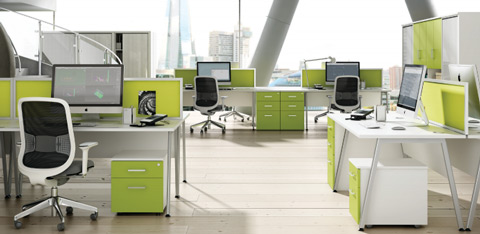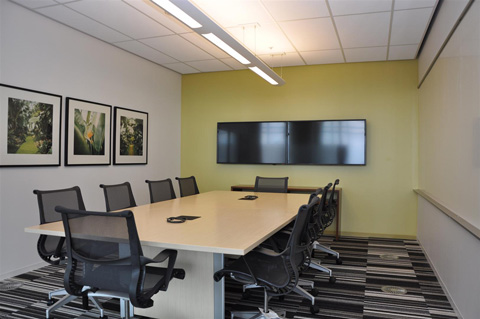
Many corporations are moving their staff into modern green offices in LEED buildings. But the left-behind furniture and equipment often end up in landfill. It’s better to recycle, resell, and donate them to minimize your footprint, recover costs, and benefit charities. Let’s see how Chevron did it and what you can learn from their experiences for your next move or renovation.
In the summer of 2013, Chevron embarked on a large scale renovation of its Canadian headquarters in Calgary with the goal of ushering its workplace into the 21st century. The 18-floor office rejuvenation was designed to introduce new technologies and provide Chevron’s employees with a more comfortable, productive environment. It’s a move echoed by many large companies in Canada, U.S., and worldwide. As office design and technology continue to evolve, leading businesses are investing to stay ahead. [Carbon49 has covered Telus’ green rooftop and RBC’s new Canadian headquarters.]
If Chevron’s renovation was conducted like most are, most of their aging office furniture and equipment would have gone to landfill. In this case it would have been 537 tonnes in total. Estimates put the amount of furniture waste produced each year in the U.S. and Canada at more than 10 million tons, with little to no data on recovery rates.
Most companies would prefer to recycle, resell, or donate their furniture and equipment but few have the time and resources to find the appropriate charities, arrange for specialized recycling collection, and to make contacts with the used office equipment markets. Who wants to add another layer of operational challenges on top of a complex office transition? It’s not hard to understand why most companies ended up calling a liquidator instead and turn a blind eye to the actual outcome.
 But what Chevron and their general contractor EllisDon did was to seek help from outside specialists. They hired Green Standards, a one-stop shop specialized in handling exactly these tasks. Inspired by the emerging circular economy, Green Standards’ model combines donation, resale and recycling channels to keep corporate office furniture, equipment and supplies out of the landfill and in use.
But what Chevron and their general contractor EllisDon did was to seek help from outside specialists. They hired Green Standards, a one-stop shop specialized in handling exactly these tasks. Inspired by the emerging circular economy, Green Standards’ model combines donation, resale and recycling channels to keep corporate office furniture, equipment and supplies out of the landfill and in use.
“Having collaborated with Green Standards on smaller decommissions since 2013, we knew the challenges and risks that come with large office transitions,” said Deborah Galley, Supervisor of Building and Office Services at Chevron. “To avoid the daily hurdles and reduce the enormous potential for waste, we planned ahead and put into practice our commitment to the community and the environment.”
Chevron and their general contractor EllisDon set an internal goal of 95% landfill diversion for goods and materials stemming from the office interior component of the renovation. The added benefit was the ability to outsource the operational challenges and acquire environmental reporting from a team of experts.
Green Standards was brought on board to solve three problems:
- To manage the redistribution of Chevron’s existing office furniture, fixtures, and equipment.
- To manage the recycling of demolition material from EllisDon’s renovation of Chevron’s space.
- To report on the environmental and social outcome of the project.
“We challenge organizations to look at their excess office products and materials differently, to see them as resources instead of waste,” said Trevor Langdon, Executive General Manager at Green Standards. “Most companies don’t realize how large these waste streams are and the benefits that come with managing them effectively.”

Green Standards put into place two processes. Its program of office asset donation, resale, and recycling was deployed to redistribute the 121 tonnes of furniture and equipment. Where conventional solutions target only valuable items and dispose of the remainder, Green Standards identifies items that can be resold or recycled through its network of partners and vendors as well as those that can be donated through its network of 10,000 non-profits. Green Standards then contracted commercial movers to relocate the items according to its multi-channel redistribution plan. This process was repeated for each of the 18 floors in a phased approach.
More than 40% of the office furniture and equipment, worth an estimated $106,000, was donated to dozens of registered non-profits in the local area, providing Chevron with the opportunity to support its community while reducing its waste. Participating organizations included Hope Mission, the Schizophrenia Alliance of Alberta, and Central Alberta Youth Unlimited.
“Chevron and Green Standards have helped us use our limited space more efficiently, making room for our growing staff,” said Jake Schellenberg, Executive Director at Central Alberta Youth Unlimited. “Perhaps more significantly, they have reduced the cost of finishing our office space and allowed us to invest more into our programming.”
With the office assets cleared from Chevron’s space, Green Standards then planned and managed the dismantling, separation, and processing of 403 tonnes of demolition materials in collaboration with EllisDon. The detailed process saw materials separated on location and transported to various recyclers capable of processing each material type, including steel, aluminum, plastic, drywall, insulation, glass, carpet, cardboard, and ceiling tiles.
“The opportunity to partner with Chevron and Green Standards to divert usable construction waste from landfill was a unique change from conventional renovation,” said Jonathan Waltr, Project Manager of Sustainable Building Services at EllisDon. “By leveraging Green Standards’ expertise and community connections, we were able to implement a diligent separation process that diverted a significant portion of waste materials. We are proud to have been a part of this process, and congratulate the project team on its achievement.”
In the end 98% of all products and materials destined for the landfill were diverted. 524 tonnes of office material and demolition waste were resold, repurposed, or recycled. This equals to 354 tonnes of CO2e offset or the carbon-carrying capacity of 9,062 trees. Chevron was able to share this success with their employees and stakeholders with the environmental and social data provided by Green Standards.
This is truly a triple bottom line approach. Chevron, EllisDon, and Green Standards joined force to bring benefits to local charities, reduced their environmental footprint, and recaptured some of the assets’ residual values. It goes to show that greening the workspace does not need to leave an eye sore in the landfill.

[…] The design is attractive to a broad spectrum of potential tenants, from large corporations seeking to align values and commitment to sustainable practices, to smaller tenants seeking well-serviced conventional office environments in an accessible, downtown location. (See also: Greening Offices Without Adding to Landfill) […]